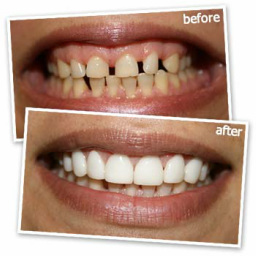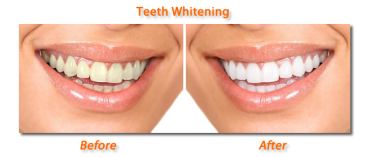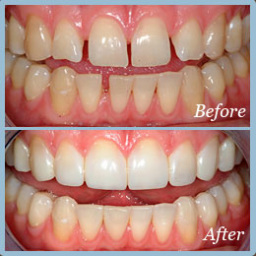
Veneers
Veneers are thin, custom-made shells made from tooth-colored materials (such as porcelain) designed to cover the front side of your teeth. To prepare for veneers, your doctor will create a unique model of your teeth. This model is sent to the dental technician to create your veneers. Before placing your new veneer, your doctor may need to conservatively prepare your tooth to achieve the desired aesthetic result. When placed, you’ll be pleased to see that veneers look like your natural teeth. With veneers, you can easily correct your teeth’s imperfections to help you have a more confident, beautiful smile. Veneers are natural in appearance, and they are a perfect alternative for patients wanting to make minor adjustments to the look and feel of their smile.
Veneers are thin, custom-made shells made from tooth-colored materials (such as porcelain) designed to cover the front side of your teeth. To prepare for veneers, your doctor will create a unique model of your teeth. This model is sent to the dental technician to create your veneers. Before placing your new veneer, your doctor may need to conservatively prepare your tooth to achieve the desired aesthetic result. When placed, you’ll be pleased to see that veneers look like your natural teeth. With veneers, you can easily correct your teeth’s imperfections to help you have a more confident, beautiful smile. Veneers are natural in appearance, and they are a perfect alternative for patients wanting to make minor adjustments to the look and feel of their smile.

Whitening
There are many products and techniques available for patients who want to achieve a whiter smile, and with so many options available, it can be difficult to choose the method that is right for you. The best way to begin any teeth whitening regimen is to schedule an appointment and talk to your doctor about the differences between in-office professional whitening and at-home whitening.
In-office teeth whitening
The first professional option is commonly referred to as “in-office” whitening. This procedure is performed in a dental office. An in-office whitening treatment may include the use of a whitening lamp or laser to enhance the effectiveness of the whitening gel by accelerating the peroxide. During an office visit, your dental professional will apply the whitening gel and, depending on the system being used, will shine a light source directly onto the teeth. The entire office visit generally takes about 30 minutes with immediate results.
Ask about our new, in office totally organic, chemical free, minimally sensitive bleaching system.
At-home teeth whitening:
Tray bleaching
Tray bleaching is a type of professional whitening that uses custom-made trays and whitening gel only available through your dentist. The whitening gel is placed in custom-fitted trays that fit perfectly over your teeth. As the peroxide in the gel breaks down, hydroxyradicals help whiten stained teeth. Unlike strips, this process whitens all your natural teeth and may contain ingredients intended to provide maximum comfort. At-home professional tray whitening generally takes 10-14 days, although you may notice results in as little as three to five days.
Teeth whitening strips
Teeth whitening strips are thin, flexible plastic (polyethylene) strips with a thin film of hydrogen peroxide bleaching on one side. Whitening strip kits come with two types of strips: strips for the upper teeth and strips for the lower teeth. The bleaching agent is applied by placing the strips across your teeth and gently pressing the strips into place to ensure contact with all your teeth. Teeth whitening strips are typically worn for about 1 to 2 hours a day, for 5 days. The duration of treatment will vary depending on the method of bleaching.
There are many products and techniques available for patients who want to achieve a whiter smile, and with so many options available, it can be difficult to choose the method that is right for you. The best way to begin any teeth whitening regimen is to schedule an appointment and talk to your doctor about the differences between in-office professional whitening and at-home whitening.
In-office teeth whitening
The first professional option is commonly referred to as “in-office” whitening. This procedure is performed in a dental office. An in-office whitening treatment may include the use of a whitening lamp or laser to enhance the effectiveness of the whitening gel by accelerating the peroxide. During an office visit, your dental professional will apply the whitening gel and, depending on the system being used, will shine a light source directly onto the teeth. The entire office visit generally takes about 30 minutes with immediate results.
Ask about our new, in office totally organic, chemical free, minimally sensitive bleaching system.
At-home teeth whitening:
Tray bleaching
Tray bleaching is a type of professional whitening that uses custom-made trays and whitening gel only available through your dentist. The whitening gel is placed in custom-fitted trays that fit perfectly over your teeth. As the peroxide in the gel breaks down, hydroxyradicals help whiten stained teeth. Unlike strips, this process whitens all your natural teeth and may contain ingredients intended to provide maximum comfort. At-home professional tray whitening generally takes 10-14 days, although you may notice results in as little as three to five days.
Teeth whitening strips
Teeth whitening strips are thin, flexible plastic (polyethylene) strips with a thin film of hydrogen peroxide bleaching on one side. Whitening strip kits come with two types of strips: strips for the upper teeth and strips for the lower teeth. The bleaching agent is applied by placing the strips across your teeth and gently pressing the strips into place to ensure contact with all your teeth. Teeth whitening strips are typically worn for about 1 to 2 hours a day, for 5 days. The duration of treatment will vary depending on the method of bleaching.

Bonding
Bonding is a conservative way to repair slightly chipped, discolored, or crooked teeth. During dental bonding, a white filling is placed onto your tooth to improve its appearance. The filling "bonds" with your tooth, and because it comes in a variety of tooth-colored shades, it closely matches the appearance of your natural teeth.
Tooth bonding also can be used for tooth fillings instead of amalgam fillings. Many patients prefer bonded fillings because the white color is much less noticeable than the silver amalgam fillings. Bonding fillings can be used on front and back teeth depending on the location and extent of tooth decay.
Bonding is less expensive than other cosmetic treatments and usually can be completed in one visit to our office. However, bonding can stain and is easier to break than other cosmetic treatments such as porcelain veneers. If it does break or chip, tell your doctor. The bonding generally can be easily patched or repaired in one visit.
Bonding is a conservative way to repair slightly chipped, discolored, or crooked teeth. During dental bonding, a white filling is placed onto your tooth to improve its appearance. The filling "bonds" with your tooth, and because it comes in a variety of tooth-colored shades, it closely matches the appearance of your natural teeth.
Tooth bonding also can be used for tooth fillings instead of amalgam fillings. Many patients prefer bonded fillings because the white color is much less noticeable than the silver amalgam fillings. Bonding fillings can be used on front and back teeth depending on the location and extent of tooth decay.
Bonding is less expensive than other cosmetic treatments and usually can be completed in one visit to our office. However, bonding can stain and is easier to break than other cosmetic treatments such as porcelain veneers. If it does break or chip, tell your doctor. The bonding generally can be easily patched or repaired in one visit.